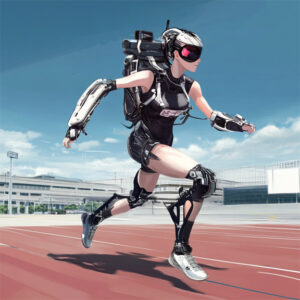 While exoskeletons are being developed primarily for military, medical and commercial applications, they have obvious potential for use in play. For example, new sports might be created in which athletes wear exoskeletons to enable greater performance.
While exoskeletons are being developed primarily for military, medical and commercial applications, they have obvious potential for use in play. For example, new sports might be created in which athletes wear exoskeletons to enable greater performance.
From a moral standpoint, the use of exoskeletons in sports designed for them raises no special issues. After all, the creation of motorized sports is as old as the motor and this territory is well known. As such, exoskeletons in sports designed for them are no different from the use of racing cars or motorcycles. In fact, exoskeleton racing is likely to be one of the first exoskeleton sports.
It is worth noting that exoskeletons could be added to existing sports such as cross-country running, track or football. But the idea of using mechanized technology in such sports doesn’t really break new ground. To illustrate, having runners compete while wearing exoskeletons would be like having bicyclists replace their pedaled bikes with electric bikes. This would simply create a new, mechanized sport.
Adding exoskeletons to existing sports could create safety problems. For example, American football with exoskeletons could be lethal. As another example, athletes running around a track with exoskeletons could result in serious collision injuries. However, these matters do not create new ethical territory. Issues of equipment and safety are old concerns and can be resolved for exoskeletons, most likely after some terrible accidents, using established moral principles about safe competition. For example, there are already principles governing the frequency and severity of tolerable injuries in sports that would also apply to exosports. Naturally, each sport does tend to have different levels of what is considered tolerable (football versus basketball, for example), so the specific details for these new sports will need to be sorted out. Another area of moral concern is the use of exoskeletons in cheating.
While current exoskeleton technology would impossible to hide during athletic competitions like running and biking, future exoskeletons could be hidden under clothing and could be used to cheat. While this would create a new way to cheat, it would not require the creation of any new ethical theory about cheating. After all, what matters most morally in cheating is the cheating, not the specific means used. As such, whether an athlete is getting an unfair edge with an exoskeleton, blood doping, performance enhancing drugs, or cutting the course they are cheating and hence doing something wrong.
While exoskeletons have yet to be used to cheat, there is already an established concept of the use of “technological fraud” in competition. The first apparent case appeared a few years ago, when a cyclist was accused of using a bike with a motor concealed in its frame. Since people had speculated about this possibility, there were already terms for it: “mechanical doping” and “bike doping.” Using a hidden exoskeleton would be analogous to using a hidden motor on a bike. The only difference is that the hidden motor directly enhances the bike while an exoskeleton for the biker would enhance them. But there is no moral difference whether the motor is enhancing the bike directly or enhancing the athlete. As such, the ethics of cheating with an exoskeleton are already settled, even before exo-cheating has occurred.
One final, somewhat sci-fi, concern is the use of exoskeletons will weaken people. While a person must move to use an exoskeleton, the ones used for play will enhance a person’s abilities and do much of the work for them. Researchers are already talking about running at 20 MPH through the woods for hours without getting tired. While I admit that this sounds fun (aside from colliding with trees), a worry is that this would be more like riding a motorcycle (which does all the work) than riding a bike (which augments the effort).
An obvious reply is to point out that I myself made the obvious comparison to riding a motorcycle. The use of an exoskeleton would not be fundamentally different from riding a motorcycle through the woods and there is nothing wrong with that (on designated trails). This is a reasonable point and I have no more objection to people exorunning (in designated areas) for entertainment than I do to people riding motorcycles (in designated areas). However, I do worry that exoskeletons could make things too easy for people.
While things like mobility scooters do exist, an exoskeleton would go beyond them. After all, a full body exoskeleton would not only provide easy mobility, but also do the work for the person’s arms. While this would be a blessing for a person with a serious medical condition, it would enable otherwise healthy people to avoid even the small amount of exercise most people cannot avoid today (like walking from their car to work or a store).
The sensible reply to my concern is to point out that most people do not use mobility scooters to get around when they do not actually need them, so the same would hold true of exoskeletons (assuming they become as cheap as mobility scooters). However, given the impact of automobiles and other technology on fitness levels, it is worth having some concern about the harmful effects of exoskeletons making things too easy. Unlike a car, a person could wear their exoskeleton into their workplace or the store, avoiding all the need to walk on their own. While the movie WALL-E did not have exoskeletons, it did show the perils of technology that makes things far too easy for humans and it is worth keeping that in mind as a (fictional) cautionary tale.

Well, an advertisement cancelled ny comment….oops…